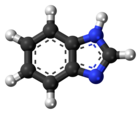Benzimidazole

| |||
| |||
| Names | |||
|---|---|---|---|
| IUPAC name
1H-benzimidazole
| |||
| Identifiers | |||
3D model (JSmol)
|
|||
| ChEBI | |||
| ChEMBL | |||
| ChemSpider | |||
| ECHA InfoCard | 100.000.075 | ||
| KEGG | |||
PubChem CID
|
|||
| UNII | |||
CompTox Dashboard (EPA)
|
|||
| |||
| |||
| Properties | |||
| C7H6N2 | |||
| Molar mass | 118.139 g·mol−1 | ||
| Melting point | 170 to 172 °C (338 to 342 °F; 443 to 445 K) | ||
| Acidity (pKa) | 12.8 (for benzimidazole) and 5.6 (for the conjugate acid) [1] | ||
| Hazards | |||
| Safety data sheet (SDS) | External MSDS | ||
Except where otherwise noted, data are given for materials in their standard state (at 25 °C [77 °F], 100 kPa).
| |||
Benzimidazole is a heterocyclic aromatic organic compound. This bicyclic compound consists of the fusion of benzene and imidazole. The most prominent benzimidazole compound in nature is N-ribosyl-dimethylbenzimidazole, which serves as an axial ligand for cobalt in vitamin B12.[2]
Benzimidazole, in an extension of the well-elaborated imidazole system, has been used as carbon skeletons for N-heterocyclic carbenes. The NHCs are usually used as ligands for transition metal complexes. They are often prepared by deprotonating an N,N'-disubstituted benzimidazolium salt at the 2-position with a base.[3][4]
Preparation
Benzimidazole is commercially available. The usual synthesis involves condensation of o-phenylenediamine with formic acid,[5] or the equivalent trimethyl orthoformate:
- C6H4(NH2)2 + HC(OCH3)3 → C6H4N(NH)CH + 3 CH3OH
By altering the carboxylic acid used, this method is generally able to afford 2-substituted benzimidazoles.[5]
Applications
Many anthelmintic drugs (albendazole, mebendazole, triclabendazole etc.) belong to the benzimidazole class of compounds.
Benzimidazole also has fungicidal properties. It acts by binding to the fungal microtubules and stopping hyphal growth. It also binds to the spindle microtubules and blocks nuclear division.
The benzimidazole opioid family includes a number of strong agents e.g. etonitazene, whose article discusses the family in some depth. [6]
See also
- Benzimidazoline
- Polybenzimidazole, a high performance fiber
- Indole, an analog with CH in place of nitrogen in position 3.
- Purine, an analog with two additional nitrogen atoms in the six-membered ring.
- Simple aromatic rings
- Benzimidazole fungicides
References
- ^ Walba, H. & Isensee, R. W. Acidity constants of some arylimidazoles and their cations. J. Org. Chem. 26, 2789-2791 (1961).
- ^ H. A. Barker, R. D. Smyth, H. Weissbach, J. I. Toohey, J. N. Ladd, and B. E. Volcani (February 1, 1960). "Isolation and Properties of Crystalline Cobamide Coenzymes Containing Benzimidazole or 5,6-Dimethylbenzimidazole". Journal of Biological Chemistry. 235 (2): 480–488. PMID 13796809.
{{cite journal}}: CS1 maint: multiple names: authors list (link) - ^ R. Jackstell, A. Frisch, M. Beller, D. Rottger, M. Malaun and B. Bildstein (2002). "Efficient telomerization of 1,3-butadiene with alcohols in the presence of in situ generated palladium(0)carbene complexes". Journal of Molecular Catalysis A: Chemical. 185 (1–2): 105–112. doi:10.1016/S1381-1169(02)00068-7.
{{cite journal}}: CS1 maint: multiple names: authors list (link) - ^ H. V. Huynh, J. H. H. Ho, T. C. Neo and L. L. Koh (2005). "Solvent-controlled selective synthesis of a trans-configured benzimidazoline-2-ylidene palladium(II) complex and investigations of its Heck-type catalytic activity". Journal of Organometallic Chemistry. 690 (16): 3854–3860. doi:10.1016/j.jorganchem.2005.04.053.
{{cite journal}}: CS1 maint: multiple names: authors list (link) - ^ a b E. C. Wagner and W. H. Millett (1943). "Benzimidazole". Organic Syntheses; Collected Volumes, vol. 2, p. 65..
- ^ etonitzene
Further reading
- Grimmett, M. R. (1997). Imidazole and benzimidazole synthesis. Boston: Academic Press. ISBN 0-12-303190-7.


